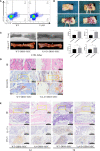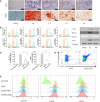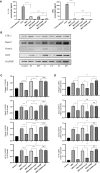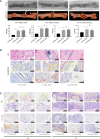HVEM Promotes the Osteogenesis of allo-MSCs by Inhibiting the Secretion of IL-17 and IFN-γ in Vγ4T Cells
- PMID: 34248977
- PMCID: PMC8261146
- DOI: 10.3389/fimmu.2021.689269
HVEM Promotes the Osteogenesis of allo-MSCs by Inhibiting the Secretion of IL-17 and IFN-γ in Vγ4T Cells
Abstract
Bone defects are a common orthopaedic concern, and an increasing number of tissue-engineered bones (TEBs) are used to repair bone defects. Allogeneic mesenchymal stem cells (allo-MSCs) are used as seed cells in many approaches to develop TEB constructs, but the immune response caused by allogeneic transplantation may lead to transplant failure. V gamma 4 T (Vγ4T) cells play an important role in mediating the immune response in the early stage after transplantation; therefore, we wanted to verify whether suppressing Vγ4T cells by herpesvirus entry mediator (HVEM)/B and T lymphocyte attenuator (BTLA) signalling can promote MSCs osteogenesis in the transplanted area. In vitro experiments showed that the osteogenic differentiation of MSCs and Vγ4T cells was weakened after co-culture, and an increase in interleukin-17 (IL-17) and interferon-γ (IFN-γ) levels was detected in the culture supernatant. HVEM-transfected MSCs (MSCs-HVEM) still exhibited osteogenic differentiation activity after co-culture with Vγ4T cells, and the levels of IL-17 and IFN-γ in the co-culture supernatant were significantly reduced. In vivo experiments revealed that inflammation in the transplanted area was reduced and osteogenic repair was enhanced after Vγ4T cells were removed. MSCs-HVEM can also consistently contribute to reduced inflammation in the transplanted area and enhanced bone repair in wild-type (WT) mice. Therefore, our experiments verified that HVEM can promote the osteogenesis of allo-MSCs by inhibiting IL-17 and IFN-γ secretion from Vγ4T cells.
Keywords: HVEM-BTLA; IL-17; MSc; Tissue engineered bone; Vγ4T cells; immunomodulatory.
Copyright © 2021 He, Xiao, Song, Zhou, Rong, He and Dai.
Conflict of interest statement
The authors declare that the research was conducted in the absence of any commercial or financial relationships that could be construed as a potential conflict of interest.
Figures






Similar articles
-
Improved Osteogenesis by HVEM-Expressing Allogenic Bone Marrow-Derived Mesenchymal Stem Cells in an Immune Activation Condition and Mouse Femoral Defect Model.Tissue Eng Part A. 2018 Aug;24(15-16):1167-1178. doi: 10.1089/ten.TEA.2017.0354. Epub 2018 Jun 20. Tissue Eng Part A. 2018. PMID: 29376477
-
Herpesvirus-Entry Mediator Inhibits the NF-κB Pathway Activated by IL-17 and Fosters the Osteogenic Differentiation of Allogeneic Mesenchymal Stem Cells.J Tissue Eng Regen Med. 2024 Aug 30;2024:8146991. doi: 10.1155/2024/8146991. eCollection 2024. J Tissue Eng Regen Med. 2024. PMID: 40225753 Free PMC article.
-
CD160 activation by herpesvirus entry mediator augments inflammatory cytokine production and cytolytic function by NK cells.J Immunol. 2013 Jul 15;191(2):828-36. doi: 10.4049/jimmunol.1300894. Epub 2013 Jun 12. J Immunol. 2013. PMID: 23761635 Free PMC article.
-
The Function of B and T Lymphocyte Attenuator and Its Role in Transplantation.APMIS. 2025 Mar;133(3):e70012. doi: 10.1111/apm.70012. APMIS. 2025. PMID: 40040475 Review.
-
BTLA/HVEM Signaling: Milestones in Research and Role in Chronic Hepatitis B Virus Infection.Front Immunol. 2019 Mar 29;10:617. doi: 10.3389/fimmu.2019.00617. eCollection 2019. Front Immunol. 2019. PMID: 30984188 Free PMC article. Review.
Cited by
-
Quercetin Preserves Oral Cavity Health by Mitigating Inflammation and Microbial Dysbiosis.Front Immunol. 2021 Nov 26;12:774273. doi: 10.3389/fimmu.2021.774273. eCollection 2021. Front Immunol. 2021. PMID: 34899728 Free PMC article.
-
Tumor Cell-Expressed Herpesvirus Entry Mediator Regulates Proliferation and Adaptive Immunity in Ovarian Cancer.Immun Inflamm Dis. 2025 Mar;13(3):e70175. doi: 10.1002/iid3.70175. Immun Inflamm Dis. 2025. PMID: 40105652 Free PMC article.
References
-
- Niemeyer P, Fechner K, Milz S, Richter W, Suedkamp N, Mehlhorn A, et al. . Comparison of Mesenchymal Stem Cells From Bone Marrow and Adipose Tissue for Bone Regeneration in a Critical Size Defect of the Sheep Tibia and the Influence of Platelet-Rich Plasma. Biomaterials (2010) 31(13):3572–9. 10.1016/j.biomaterials.2010.01.085 - DOI - PubMed
Publication types
MeSH terms
Substances
LinkOut - more resources
Full Text Sources
Research Materials

